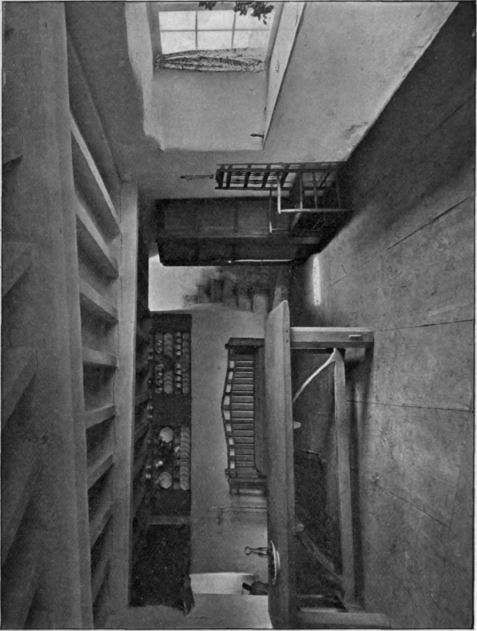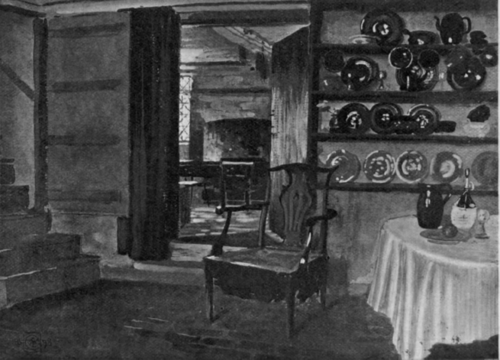The Dwelling. Part 6
Description
This section is from the book "Ideals In Art: Papers Theoretical Practical Critical", by Walter Crane . Also available from Amazon: Ideals in Art: Papers Theoretical, Practical, Critical.
The Dwelling. Part 6
The reign of the big plate-glass window, I believe, is over, and certainly in such a climate as ours one needs as a rule to be assured one is really indoors. Certainly, nothing makes so much difference to the aspect and comfort of a room or house as the position and size of the windows. I have a preference for casements with plain-leading, and if the window is high, stained glass may find an appropriate place above the transoms, or in windows where veiled light is needed, or plain roundels where a view from within or without is not desired.
There is no doubt a determined effort in the direction of a return to simplicity, both in house designing, furniture, and decorations on the part of the more refined and cultured, as a reaction perhaps against the ostentation and luxury of the appointments of the extremely and newly rich, and the pretentiousness of the decorations of monster hotels, where coarse imitations of decadent periods of French art do duty for splendour, though even here of late the simpler taste has asserted itself. There is indeed some danger that oak or green-stained furniture and whitewashed walls may come to be considered as outward and visible signs of an inward and spiritual grace, when perhaps they are only the fashion.

Stoneywell Cottage, Interior of Living-room
Furniture Designed by Ernest W. Gimson, Sidney H. Barnsley, and Ernest A. Barnsley
"Have nothing in your house but what you believe to be beautiful or what you know is useful," was the straightforward advice of that great conservative revolutionist in English decorative art and other things - William Morris - and he certainly acted up to it in his own house.
As to the useful, there are no complications about that. A room with a definite purpose has character, and is always more or less picturesque. The kitchen is generally the most picturesque room in the house, yet usually entirely devoid of what maybe called decoration. Its objects of art are merely the tools of the workshop, the bright brass and copper vessels, the dish-covers gleaming like polished armour from the white walls. The rows of blue and white plates and dishes upon the dresser, and all the simple but sufficient hand tools of the cook's office about, easily make up an attractive Dutch picture.
The real aesthetic dangers come in to the rooms which have no visible means of subsistence, so to speak. The dining-room, perhaps for this reason, is more successful generally than the drawing-room, and there exists a sort of tradition that it should be warm and rich in colour. Silver plate often gleams pleasantly from the sideboard, and the furniture is simple and massive in its lines. An old English dining-room, with Chippendale or Sheraton furniture, has a character and distinction of its own. A library, again, is almost sure to look a habitable room, and there are few more agreeable linings to walls than books, and here we must depend upon the taste of the binders, as well as on the furniture provided for the mind. There would, however, be room for the professional decorator upon the ceiling, and I mind me of the lovely plaster ceilings to be met with in sixteenth-century houses, sometimes armorial, sometimes emblematic - such as those at Knole and Blick-ling. In plaster work we have a beautiful and permanent kind of decoration which we owe to Italy, but which seems to have become quite domesticated here,and to have developed its own forms with us. The plain white, flat ceiling of the ordinary modern dwelling-house is the last relic, and even this used to have a big plaster rose screwed up in the middle, from which sprouted the gaselier; but one need not regret the departure of both excrescences in favour of the clean and pendulous shaded electric light, with light and simple brass or copper fittings. Our plasterers, however, might be able to throw some delicate ribs or pleasant spacing of simple sprays and devices upon the inviting plain of white plaster over our heads, or, if not, why not let the joists show and paint or stencil them with running leaf patterns, or paint them black, leaving white plaster between? Mr. George Walton, one of the most tasteful and original decorators in the newer mode, and under the Glasgow influence, showed a new treatment of a ceiling in glass and metal, together with a completely decorated and fitted interior at the recent Glasgow Exhibition. A plaster ceiling demands a frieze, and both may be effective either plain or coloured. This would depend upon whether a light, dark, or rich effect were required in the room. There is much charm in the coloured treatment of plaster, especially of figure designs in low relief as in the work of Mr. Anning Bell,

From a Sketch by Walter Crane Old English Farmhouse Interior (Kent)

Combe Bank, Sevenoaks, the Saloon
The Stamped Leather, Plaster Ceiling, Chimney Breast, smaller Frieze Panels, and Door Panels Designed, Modelled, and Painted by Walter Crane
Mr. Pomeroy, and Mr. Gerald Moira, though these require large rooms, public halls, or churches.
Continue to:


